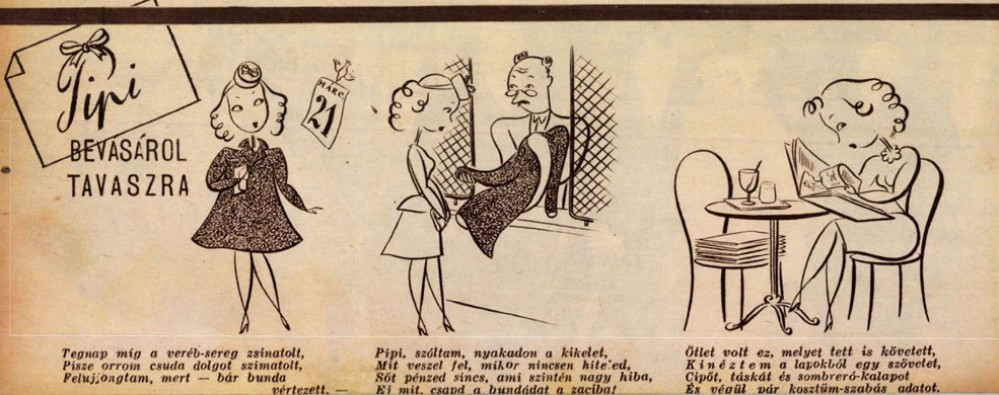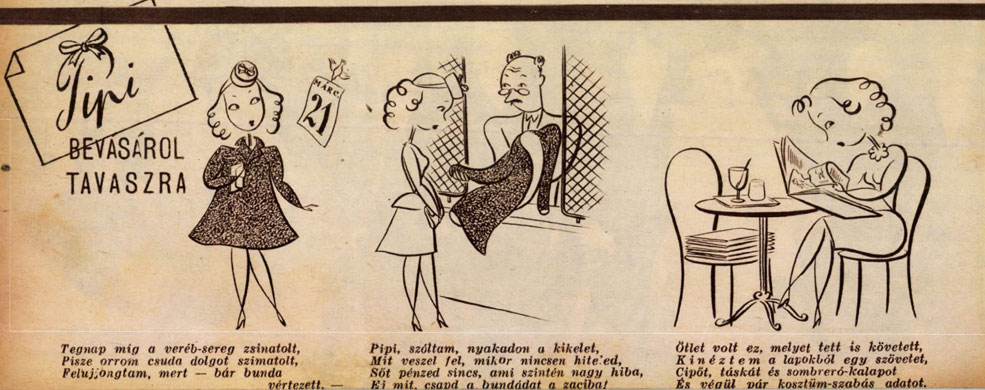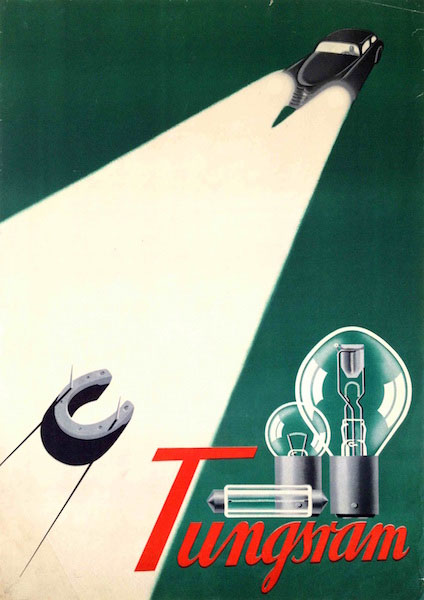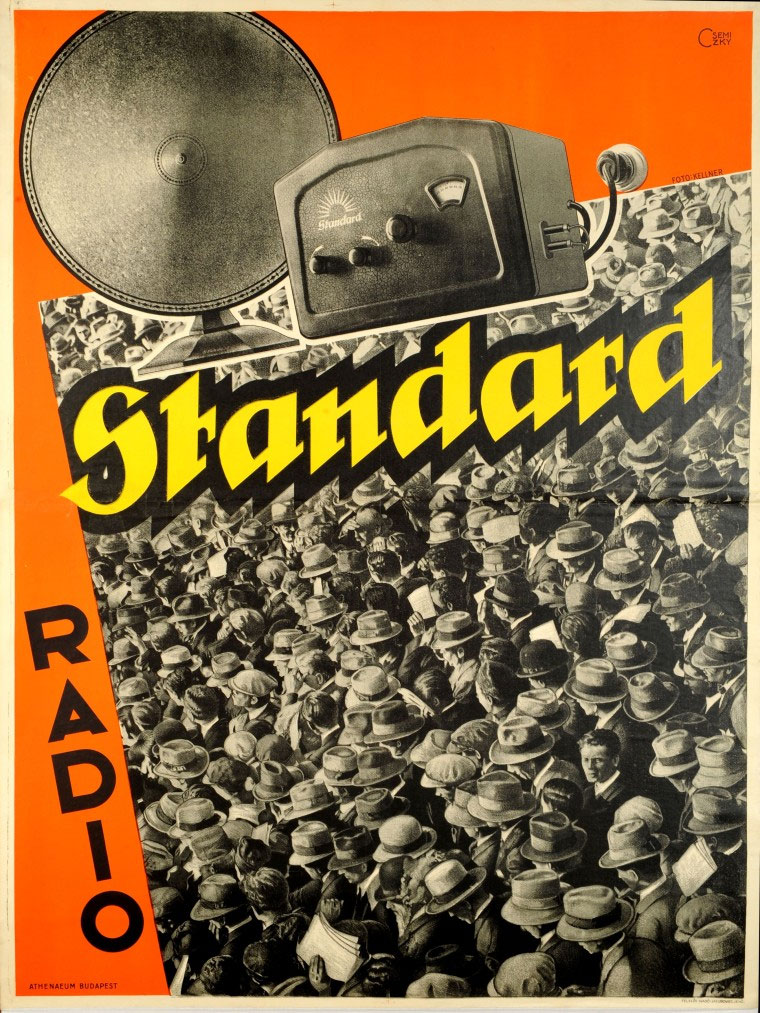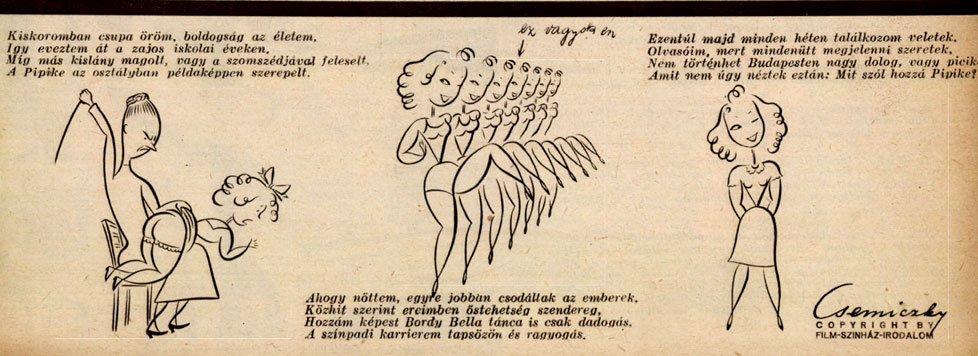'Pipi' strip from Film Színház Irodalom (1941).
Tihamér Csemiczky was a Hungarian graphic artist, painter, writer and pharmacist. During the 1930s, he was one of the foremost modernist poster designers in his home country. In his essays, he was at the vanguard of new technologies, and a keen promoter of the radio. In the 1940s, for the magazine Film Színház Irodalom, he made the comic strip about the aspiring actress 'Pipi' (1941-1944).
Early life and career
Tihamér Csemiczky was born in 1904 in Törtel, a town in central Hungary. He originally studied Pharmacy, but at the same time took courses in Graphic Design (1924-1925). By 1926, he was a graphic artist for the Hungarian radio newspaper Magyar Rádióujság, and in the following year he began making posters and illustrations. Later that decade, he attended the atelier of the Bauhaus graphic designer Sándor Bortnyik, and underwent many influences from his teacher's geometric, constructivist poster style. The studio participated in the 1929 Budapest International Fair, where one of Csemiczky's designs won the competition.
Poster designer
Csemiczky continued to design posters throughout the 1930s and 1940s, and with István Irsai he was one of the main artists who continued to work in the modernist style. Csemiczky's posters were characterized by their strong colors, flat shapes and modern typography, while his collages made use of self-made photographs. His work shows a great sense of modern technology. Csemiczky designed posters promoting electronic equipment, for instance Tungsram light bulbs. The radio companies Standard, Orion and Telefunken were also among his clientele.
Posters designed by Tihamér Csemiczky for Tungsram and Standard.
Magazine work
In the 1930s and 1940s, Csemiczky did magazine work as well. He served as art director for several magazines, and often wrote articles about art and science. He remained an illustrator for Magyar Rádióujság, and wrote many essays promoting the radio as an effective tool for popular education. His writings were also read during radio broadcasts. Between 1940 and 1944, Csemiczky was art director, editor and cartoonist for the cultural magazine Film Színház Irodalom.
For this magazine, Csemiczky also created the comic strip 'Pipi a görl' (1941-1944), often shortened to just 'Pipi'. Debuting in issue #10 of 1941, Pipi is a poor and not too bright dancing girl, who aspires to become an actress. Csemiczky drew 148 episodes, all with text captions set to rhyme. The feature ran for three years, until in April 1944 the magazine was abruptly canceled, following the German invasion of Hungary. Film Színház Irodalom reappeared after the war.
World War II
In 1940, during World War II, Hungary joined the Axis Powers, effectively supporting Hitler, Mussolini and the Japanese forces of Tojo. Despite all the danger, Csemiczky bravely hid Jewish people in his home. On 4 December 1943, Csemiczky had his work exhibited in Budapest. By 1944, the Hungarian government changed sides and started peace negotiations with the United States and Russia. In March of that same year, the German army invaded Hungary and occupied the country. Czemiczky was arrested for hiding Jews and imprisoned. In early 1945, he managed to escape.
Post-war years
In 1945, Csemiczky briefly worked as editor of the political and literary magazine Újság. However, only eight issues were published because of post-war paper shortage. After World War II, Csemiczky had his own pharmacy in Abony, Pest County. He later returned to graphic design, making commercial posters for the export companies Artex and Medimpex. Csemiczky also designed leaflets and packages for pharmaceutical companies. He also tried to relaunch 'Pipi', but under a different title and in another magazine, Dolgozók Világlap. Now named 'Cilike', the female protagonist was a more general pretty girl without a clear profession. The comic also promoted WU2 shampoo.
Death
Tihamér Csemiczky was additionally a painter, working in the tradition of the "Rome School" (a 1930s artist group who attended the Hungarian Academy in Rome). The artist passed away in Budapest on 9 August 1960, at the age of 56. In 1964, a memorial exhibition was held at the Hungarian National Gallery. One year later, a memorial plaque was attached to his house.


